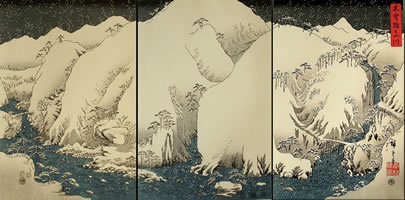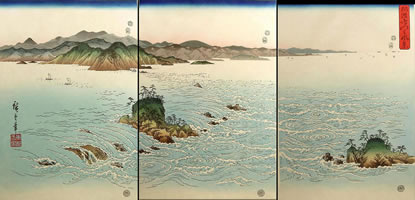 Beyond the Notes:
Beyond the Notes:
Setsugekka
Setsugekka (Snow, Moon, and Flowers) is an 1857 series of three triptychs (artworks in three sections) by the Japanese master Ando Hiroshige (1797-1858). These woodblock prints, or Ukiyo-e ("pictures of the floating world"), convey Hiroshige's vision of three different real-world landscapes representing the traditional thematic triad of snow (setsu), moon (getsu), or flowers (ka).
Hiroshige's prints inspired Nell Shaw Cohen to create Setsugekka, a work for violin and piano in three short movements (composed spring 2011). Each of the movements responds to the atmosphere and mood of the individual triptychs in the series: I. Mountain and River on the Kiso Road, II. Panorama of the Eight Views of Kanazawa under a Full Moon, and III. The Whirlpools of Naruto in Awa Province.
Play the audio below each image to hear a brief excerpt from that movement (and click the image to view a larger version):

Mountain and River on the Kiso Road

Panorama of the Eight Views of Kanazawa under a Full Moon

The Whirlpools of Naruto in Awa Province
Hiroshige and the World of Japanese Woodblock Prints
By the 1830s, woodblock printing was a well-established market in Edo, Japan (now Tokyo). Print publishers worked to finance the production of fashionable art in print form. Publishers commissioned artists, like And Hiroshige (1797-1858), to design prints which were then carved by professional woodblock carvers and printed by professional woodblock printers.
Hiroshige was a poor samurai who worked as a firefighter and part-time artist to make ends meet. He learned to design woodblock prints in the famous Utagawa school, which was responsible for educating other famous woodblock print designers such as Toyokuni and Kunisada. Hiroshige started creating prints during the early 1810s, but it wasn’t until he began dedicating his complete attention to art in the early 1830s that his career began to take off.
Landscapes became a viable medium for woodblock printing in the 1830s with the import of the pigment "Prussian Blue," making it possible to create ever-more vibrant blues and greens (essential to creating effective landscape prints). The viability of landscapes, and the new pigment, was solidified after the woodblock artist Hokusai released his famous landscape series "36 Views of Mount Fuji." The popularity of this series, and quality of Hokusai’s landscapes, encouraged Hiroshige to push head-long into focusing on landscapes as an artistic medium and challenged him to create ever-better works of art.
Text by John Resig (ukiyo-e.org), edited by Nell Shaw Cohen.
Video: An Introduction to Japanese Woodblock Prints